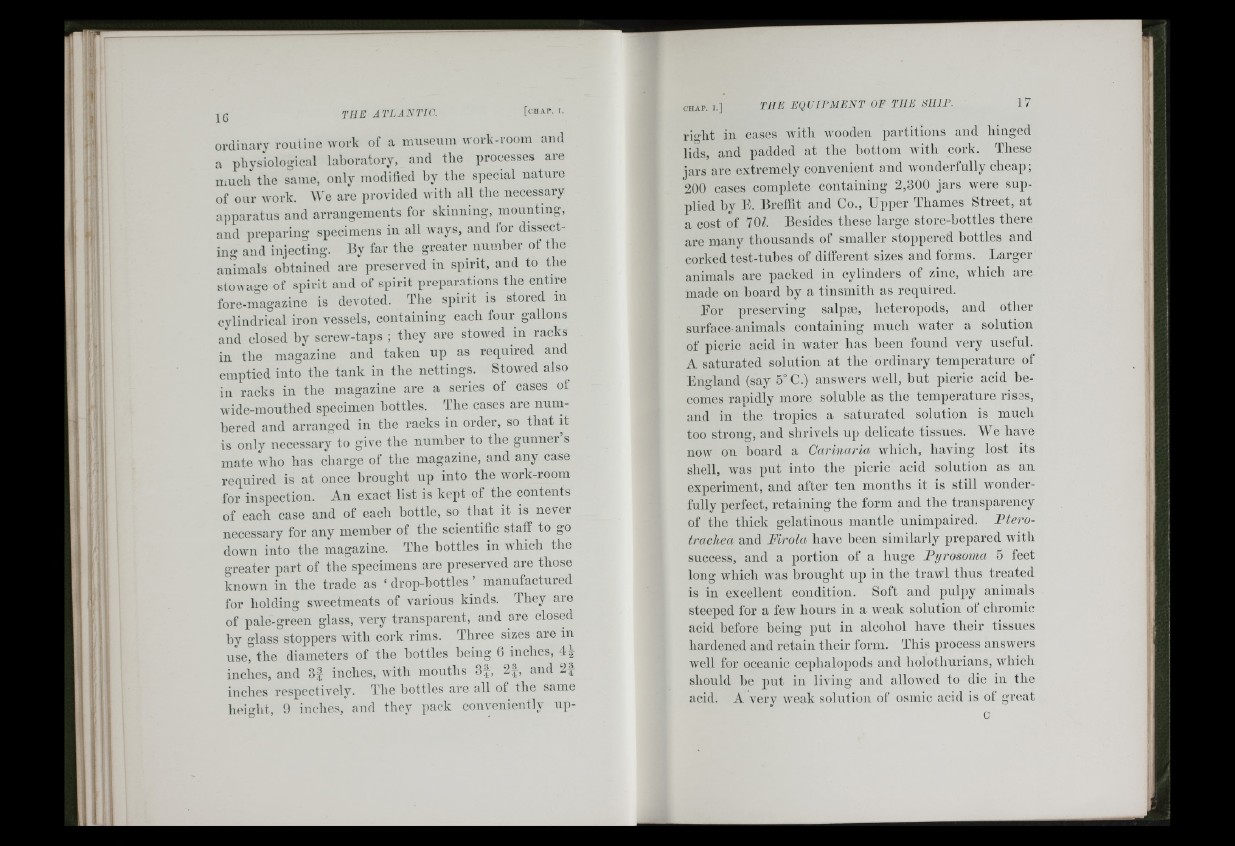
e
Ííií
ñ
-Üi
13
ordinary routine Avork of a nmscuui AA'ork-voom and
a physiological laboratory, and the processes are
much the same, only modified hy the special nature
of our AVork. AVe are provided Avith all the necessary
apparatus and arrangements for skinning, mounting,
and preparing specimens in all ways, and lor dissecting
and injecting. By lav tlie greater number of the
anhnals obtained are preserved in spirit, and to the
stowage of spirit and of spirit preparations the entire
fore-magazine is devoted. The spirit is stored in
cylindrical iron vessels, containing each four gallons
and closed hy screw-taps ; they are stowed in racks
in the magazine and taken up as required and
emptied into the tank in the nettings. Stowed also
in racks in the magazine are a series ol cases of
wide-mouthed specimen bottles. The cases are numbered
and arranged in the racks in order, so that it
is only necessary to give the number to the gunner’s
mate who has charge of the magazine, and any case
required is at once brought up into the work-room
for inspection. An exact list is kept of the contents
of each case and of each hottle, so that it is never
necessary for any member of the scientific staff to go
doAvn into the magazine. The bottles in Avhich the
greater part of the specimens are preserved are those
known in the trade as ‘ drop-hottles ’ manuffictured
for holding sAveetmeats of various kinds. They are
of pale-green glass, very transparent, and are closed
hy glass stoppers AAutli cork rims. Three sizes are in
use, the diameters of the bottles being G inches, dj
inches, and 3 f inches, Avith mouths 3|^, 2f, and 2 j
inches respectively. The bottles are all of the same
height, 0 inches, and they pack conveniently npright
in cases with wooden partitions and hinged
lids, and padded at the hottom Avith cork. These
jars are extremely convenient and Avonderfully cheap;
200 cases complete containing 2,300 jars were supplied
hy B. Breifit and Co., Upper Thames Street, at
a cost of 70/. Besides these large store-hottles there
are many thousands of smaller stoppered bottles and
corked test-tubes of different sizes and forms. Larger
animals are packed in cylinders of zinc, which are
made on hoard by a tinsmith as required.
Bor preserving salpm, lieteropods, and other
surface-animals containing much Avater a solution
of picric acid in water has heen found very useiul.
A saturated solution at the ordinary temperature of
England (say 5°C.) answers Avell, hut picric acid becomes
rapidly more soluble as the temperature rises,
and in the tropics a saturated solution is much
too strong, and shrivels up delicate tissues. AYe have
now on hoard a Carinaría which, having lost its
shell, Avas put into the picric acid solution as an
experiment, and after ten months it is still Avonderfully
perfect, retaining the form and the transparency
of tlie thick gelatinous mantle unimpaired. Etero-
trachea and Firola have heen similarly prepared Avitli
success, and a portion of a huge Eyrosoma 5 feet
long which w’as brought up in the traAvl thus treated
is in excellent condition. Soft and pulpy animals
steeped for a few hours in a weak solution ot chromic
acid before being put in alcohol have their tissues
hardened and retain their form. This process answers
well for oceanic cephalopods and holothurians, Avliicii
should he put in living and alloAvcd to die in the
acid. A very Aveak solution of osmic acid is of great
C